
95% of researchers rate our articles as excellent or good
Learn more about the work of our research integrity team to safeguard the quality of each article we publish.
Find out more
ORIGINAL RESEARCH article
Front. Sustain. Food Syst. , 12 February 2025
Sec. Crop Biology and Sustainability
Volume 9 - 2025 | https://doi.org/10.3389/fsufs.2025.1544696
 Selvaraj Selvakumar1
Selvaraj Selvakumar1 Thiruvengadam Ragavan1*
Thiruvengadam Ragavan1* Arumugam Gurusamy1
Arumugam Gurusamy1 James Prabhaharan1
James Prabhaharan1 Mahalingam Gunasekaran2
Mahalingam Gunasekaran2 Thangasamy Sivakumar1
Thangasamy Sivakumar1 Elangovan Subramanian3*
Elangovan Subramanian3* Suramani Rani1
Suramani Rani1 Bangaru Arthirani1
Bangaru Arthirani1 Arumugam Sathishkumar1
Arumugam Sathishkumar1 Syed Abul Hassan Hussainy1
Syed Abul Hassan Hussainy1Cotton (Gossypium spp.), often referred to as “white gold” and “the king of fibers”, is a major commercial fiber crop cultivated across various agroclimatic conditions, primarily used in the textile industry to manufacture fabrics. However, conventional white cotton production is associated with several environmental challenges including excessive water consumption, reliance on synthetic chemicals and the use of synthetic dyes, which contribute to soil degradation, water pollution and health hazards for farmers. In contrast, organic coloured cotton presents a sustainable alternative by naturally producing coloured fibres without the need for synthetic dyes. Additionally, it enhances soil fertility, conserves water and minimizes chemical inputs, providing ecological benefits while supporting the well-being of farming communities. The field experiments were carried out at the Central Farm, Agricultural College and Research Institute, TNAU, Madurai, Tamil Nadu, during the Kharif 2023 and Summer 2024 seasons. The present study aimed to evaluate the impacts of various nutrient management practices on the growth characteristics, yield attributes and yield of coloured cotton (Gossypium hirsutum L.) cv. Vaidehi 1. The experiment was designed using a randomized block design with nine treatments based on N-equivalence using different organic manures compared to inorganic fertilizers and replicated three times. The results indicated a significant increase in the growth characters (plant height, number of vegetative branches plant−1 and number of fruiting branches plant−1), yield attributes (number of fruiting points plant−1, number of bolls plant−1, number of bolls m−2, boll setting % and boll weight) and yield (seed cotton yield, lint cotton yield, stalk yield and biological yield) of coloured cotton with the application of 100% NPK applied through site-specific recommendation (T2), which was statistically on par with 100% NPK through blanket recommendation (T1). These were followed by the organic treatments like complete organic package (T9), cover crop with vermicompost (T4), cover crop with poultry manure (T5) and all other organic treatments during both seasons. No significant variations were recorded in the first fruiting node, length of fruiting branches as well as harvest index and lint percentage across the different nutrient management strategies.
Cotton (Gossypium spp.), often referred to as “white gold” and the “king of fibre crops”, is a vital commercial fibre crop cultivated across diverse agroclimatic conditions and is primarily utilized in the textile industry for fabric production (Aruna et al., 2020; Sahare et al., 2022) contributing 85% of raw materials to the textile industry and 16–24% of global edible oil production (Ibrahim et al., 2022; Dhamodharan et al., 2024). In India, cotton contributes 80% of global natural fibre production (Townsend, 2020), 1.5% of GDP (Gross Domestic Product) and 7.1% of agricultural value addition (Jan et al., 2020; Laghari et al., 2024) provides livelihoods for around 5.8 million farmers and 50 million people through its production, processing and trade activities (TexMin, 2023). Cotton is a dual-purpose crop cultivated for both fibre and oil production (Ali et al., 2019). Cottonseed comprises 20–25% protein and 20–25% oil, making it a key resource for the food and feed industries, with a fatty acid composition of around 26% palmitic, 2% stearic, 15% oleic and 55% linoleic acids. Globally, cottonseed oil is the third most produced vegetable oil after rapeseed and soybean, supporting both food and animal feed sectors (Liu et al., 2012; Selvakumar et al., 2022).
Cotton is grown worldwide over an area of 30.65 million hectares, yielding around 41.60 million tonnes annually with an average productivity of 1,360 kg ha−1. India leads in cotton cultivation, accounting for 41.43% of the global area. Within India, cotton occupies an area of 12.70 m ha with an annual production of 10.95 million tonnes and accounts for around 26.32% of the total global cotton production. However, the national productivity of cotton remains low at 860 kg ha−1 for seed cotton and 441 kg ha−1 for lint cotton compared to higher yields in countries like China (3,760 kg ha−1) and the USA (1,270 kg ha−1) (USDA, 2024). In Tamil Nadu, cotton is cultivated over 0.09 million hectares with a production of 0.19 million bales and productivity of 710 kg ha−1 of seed cotton and 364 kg ha−1 of lint cotton (AICRIP, 2024).
India ranks second globally in total cropped area, covering 202.07 million hectares. The country’s annual fertilizer consumption includes 17.63 million tonnes of nitrogen (N), 6.91 million tonnes of phosphorus (P2O5) and 2.68 million tonnes of potassium (K2O). In cotton cultivation, the cropped area covers 12.44 million hectares, accounting for 1.51 million tonnes of nitrogen, 0.61 million tonnes of phosphorus and 0.20 million tonnes of potassium, ranking third in total fertilizer consumption after rice and wheat (Ludemann et al., 2022).
The ongoing energy crisis rising prices of N, P2O5 and K2O fertilizers have led to increased costs and limited availability of chemical fertilizers in agricultural production. Although the adoption of high-input technologies has enhanced crop yields and labour efficiency in modern agriculture, there are increasing concerns about their detrimental effects on soil health and environmental sustainability. In particular, cotton cultivation in India is responsible for more than 55% of the country’s agrochemical consumption (Patil et al., 2021). The rising costs and environmental drawbacks of conventional cotton farming, particularly the excessive use of chemical fertilizers and pesticides, have made it increasingly unsustainable. These practices contribute to soil degradation, water pollution and biodiversity loss. In response to these challenges, transitioning to organic cotton cultivation has been recognized as a sustainable approach that prioritizes soil health, biodiversity conservation and environmental sustainability.
Worldwide, organic cotton is grown on 0.62 million hectares of certified land and 0.29 million hectares under conversion, with an annual production of 0.34 million tonnes from certified areas and 0.18 million tonnes from in-conversion areas. It is cultivated in 21 countries with eight countries contributing 97% of the total production. India leads with 38% followed by Turkey (24%), China (10%), Kyrgyzstan (9%), Tanzania (6%), Kazakhstan (4%), Tajikistan (4%) and the US (2%). The remaining 13 countries collectively produce only 3% of the global organic cotton production (OCMR, 2022).
The Indian government in collaboration with the textile industry, is actively encouraging the cultivation of coloured cotton supported by continuous research initiatives. Recent advancements in coloured cotton research have demonstrated the potential to enhance its productivity, staple length and fibre strength can be improved to match the textile quality standards of white cotton. Coloured cotton is currently cultivated on a limited scale, primarily in regions such as Dharwad (Karnataka), Coimbatore (Tamil Nadu), Vidarbha (Maharashtra) and Guntur (Andhra Pradesh) with an estimated total cultivation area of around 80 hectares and an annual production of approximately 33 tonnes (Chockalingam, 2020).
Organic white cotton production often relies on chemical dyes during processing, which can lead to serious environmental challenges including water pollution from dye effluents, the generation of toxic waste and adverse health effects on farmers and nearby communities exposed to harmful chemicals (Tinku et al., 2024). Shifting to naturally coloured cotton offers a sustainable alternative by reducing reliance on artificial dyes, thereby minimizing environmental pollution and health risks. The elimination of dyeing processes not only reduces the ecological footprint but also decreases overall fabric production costs. Furthermore, naturally coloured cotton requires less water and energy for processing, contributing to its greater sustainability. Naturally coloured cotton typically has shorter and coarser fibres due to the presence of pigments that influence the growth and structure of the fibres. This unique characteristic can pose challenges in terms of yarn strength, uniformity and blending with other fibres like polyester. However, the natural pigments reduce the need for synthetic dyes, making it an eco-friendly option. While its shorter fibre length may impact profitability compared to white cotton, it can be marketed as a premium product for sustainable and environmentally conscious textile applications, which could help balance the reduced production costs associated with dye-free fabric manufacturing (Keshamma, 2022; Naoumkina et al., 2024).
Nitrogen is the primary nutrient absorbed by cotton and plays a crucial role in regulating its growth cycle, maturity, productivity and fibre quality (Iqbal et al., 2020; Kumar et al., 2022). It enhances key physiological processes such as chlorophyll synthesis, carotenoid accumulation, electron transport efficiency and increases concentrations of free amino acids, soluble proteins and specific leaf nitrogen. These parameters are closely linked to the overall growth, yield and fibre characteristics of cotton (Khan et al., 2017; Snider et al., 2021). Organic inputs such as cover crops, green manures, vermicompost, poultry manure, farmyard manure and biofertilizers can help to maintain soil health by enhancing organic matter, microbial activity and soil physicochemical properties. These organic practices serve as an eco-friendly alternative to inorganic nutrients, promoting long-term soil sustainability and crop productivity (Tinku et al., 2024). Therefore, various organic nutrient management strategies such as complete organic packages, the integration of cover crops with vermicompost, poultry manure and farmyard manure (based on N-equivalence) can be adopted as compared to inorganic treatments including site-specific and blanket recommendations. To address these challenges, the current study aimed to evaluate the impact of various nutrient management strategies on the growth, yield components and productivity of coloured cotton.
Field experiments were carried out at the Central Farm, Department of Agronomy, Agricultural College and Research Institute, Tamil Nadu Agricultural University, Madurai, Tamil Nadu, during two consecutive seasons: Kharif 2023 (June–July) and Summer 2024 (February–March). The site is geographically located in the Southern Agroclimatic Zone of Tamil Nadu at 9°54′N latitude, 78°54′E longitude and an elevation of 147 m above mean sea level. The experimental site experiences a tropical climate with an average annual rainfall of 846 mm. During Kharif 2023, the mean maximum and minimum temperatures were 35.10°C and 26.44°C, respectively, with relative humidity recorded at 84.21% (07:22 h) and 61.13% (14:22 h) (Figure 1). In Summer 2024, the mean maximum and minimum temperatures were 36.5°C and 30.2°C, respectively, with relative humidity recorded at 84.72% (07:22 h) and 50.47% (14:22 h) (Figure 2).

Figure 1. Weather at Central Farm, Department of Agronomy, Agricultural College and Research Institute, Tamil Nadu Agricultural University, Madurai, Tamil Nadu during Kharif 2023.
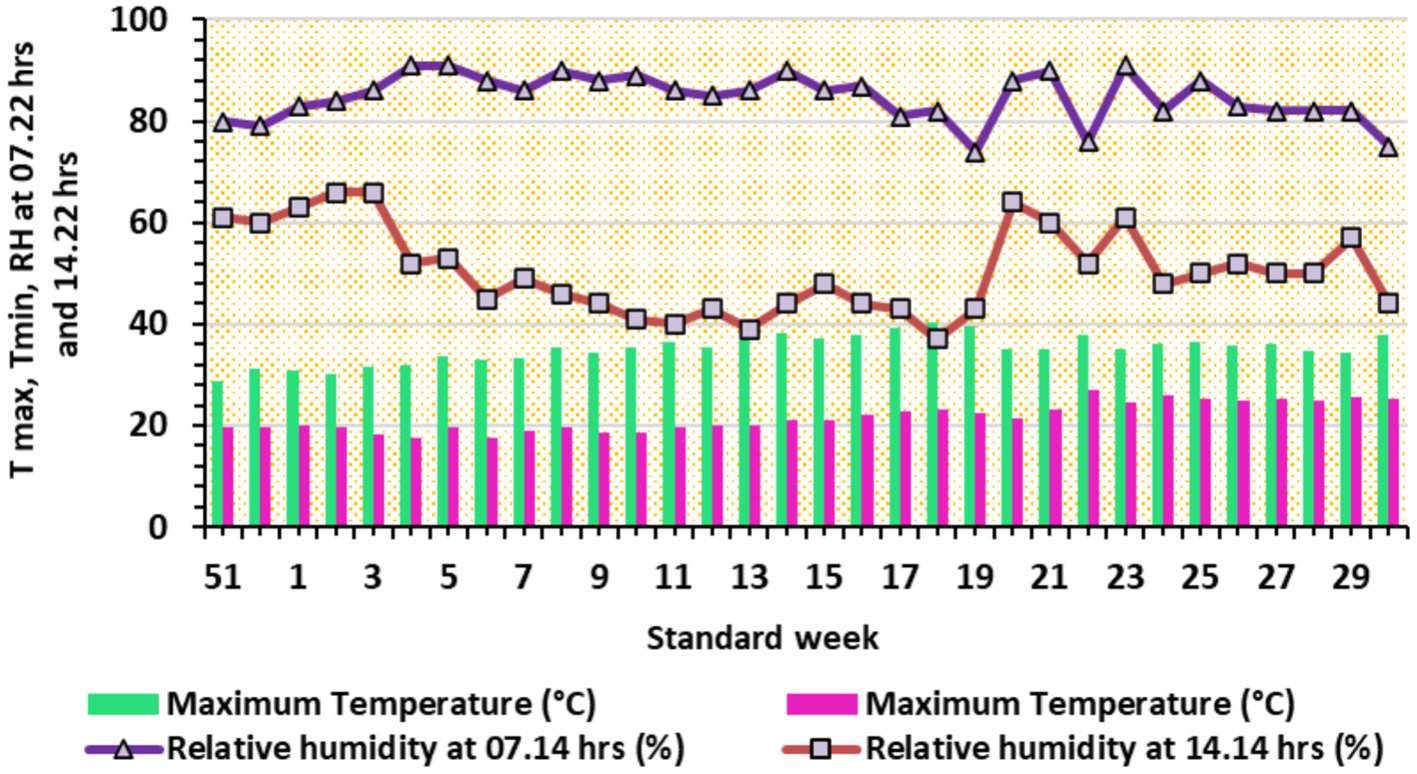
Figure 2. Weather at Central Farm, Department of Agronomy, Agricultural College and Research Institute, Tamil Nadu Agricultural University, Madurai, Tamil Nadu during Summer 2024.
The experiment consisted of nine treatments including T1—100% NPK through blanket, T2—100% NPK through site-specific, T3—cover crop + 75% N through farm yard manure, T4—cover crop + 75% N through vermicompost, T5—cover crop + 75% N through poultry manure, T6—green manure + 75% N through farm yard manure, T7—green manure + 75% N through vermicompost, T8—green manure + 75% N through poultry manure, T9—complete organic package (cover crop + organic manure + biofertilizers + bio agents + foliar spray). Organic manures were applied at 75% nitrogen equivalence to evaluate the impacts of organic and inorganic nutrient management on coloured cotton. Each treatment combination was replicated three times. Composite soil samples were collected randomly from the research field prior to conducting the experiment. The pre-sowing soil samples were air-dried, powdered, sieved (2 mm) and processed for analysis of various primary physico-chemical properties (Table 1) including texture, pH, EC, organic carbon, organic matter, available N, P, and K. The primary physicochemical properties of the experimental soil were analyzed using standard methods including Robinson’s International pipette method for texture (Piper, 1966), an “ELICO” pH meter for pH (Jackson, 1973), an “ELICO” conductivity bridge for Electrical conductivity (Jackson, 1973), alkaline permanganate for nitrogen (Subbiah and Asija, 1956), Olsen colorimetry for phosphorus (Olsen et al., 1954), neutral normal ammonium acetate for potassium (Stanford and English, 1949) and Chromic acid wet digestion for organic carbon (Walkley and Black, 1934). The soil organic matter was estimated by multiplying the organic carbon content by a factor of 1.724 (Walkley and Black, 1934).
The field experiment was conducted in a randomized block design with nine treatments and three replications over two consecutive seasons Kharif 2023 and Summer 2024. The gross and net plot sizes were 5.4 m length × 4.5 m breadth and 3.6 m length × 2.7 m breadth, respectively. Treatments were randomly assigned within each replication to minimize experimental error. The field was prepared to a fine tilth, and the cotton variety Vaidehi 1 (dark brown) was selected as the seed material based on its natural pigmentation, superior fibre quality, resistance to pests and diseases, and suitability for the local agroclimatic conditions of Madurai, Tamil Nadu. The combination of these attributes ensures that this coloured cotton variety is well-suited for sustainable farming practices and offers potential benefits for eco-friendly textile production. Cowpea (Pusa 152) was used as a cover crop and sunhemp (ADT 1) as green manure, both incorporated at 50% flowering stage (45 days after sowing). Cotton seeds were sown by dibbling at a depth of 3 cm, with a seeding rate of 6 kg ha−1 and spacing of 90 × 45 cm.
The inorganic fertilizers were applied as per the recommended treatment schedule of 80:40:40 kg of N, P2O5, and K2O ha−1 (100% NPK kg ha−1). The nitrogen, phosphorus and potassium were applied through urea (46% N), single super phosphate (16% P2O5) and muriate of potash (60% K2O), respectively. The 100% N, P2O5 and K2O were applied basally before sowing. Soil testing prior to the experiment showed low available nitrogen, medium available phosphorus and high available potassium levels. In the site-specific recommendation, to adjust the soil nutrient status to a medium level across all nutrients, nitrogen was increased by 25% and potassium was reduced by 25%. Therefore, the site-specific fertilizer recommendation was adjusted to 100:40:30 kg of N, P2O5, and K2O ha−1 (100% NPK kg ha−1). The quantity of blanket and site-specific recommendation of inorganic nutrients are detailed in Table 2.

Table 2. Quantity of blanket and site-specific recommendation of inorganic nutrients—(100% RDF: 80:40:40 NPK kg ha−1).
The total requirement of organic manures was calculated by its N content and incorporated 1 day before sowing to the respective treatment plots on the basis of 75% of N equivalent to that of recommended dose of nitrogen (RDN) on dry weight basis. The quantity of organic manures prevailed in Table 3. Biofertilizers Azospirillum and Phosphobacteria (2 kg ha−1) and bio-control agents Trichoderma viride and Pseudomonas fluorescens (2.5 kg ha−1) were applied basally. A foliar spray of PPFM (1%) was applied @ 5 liters per hectare during flowering and boll development stages. All agronomic practices, such as water management, intercultural operations and plant protection measures were carried out following the standard protocols outlined in the CPG (2020).
Five tagged plants were randomly sampled from each treatment plot to measure growth parameters such as plant height (PH), the number of vegetative branches plant−1 (NVB plant−1), First fruiting node (FFN), the number of fruiting branches plant−1 (NFB plant−1) and length of fruiting branches (LFB). Using a linear meter scale, the plant height was measured from the cotyledonary node to the tip of last opened leaf and length of fruiting branches were recorded from the five tagged plants and average was expressed as cm. The main stem nodes were recorded by identifying the node above the cotyledonary node as node one and counting sequentially upward to the node producing the first fruiting branch.
The number of fruiting points per plant (NFP plant−1) was recorded at 30 days intervals, beginning from the square formation stage (30 DAS) until harvest (150 DAS). Similarly, the cumulative counts of number of bolls per plant (NB plant−1) and number of bolls per square meter (NB m−2) were recorded for tagged plants in each treatment, from the boll formation stage (60 DAS) to harvest (150 DAS) at 30 days intervals. The averages were calculated and presented as numerical values. The boll setting percentage represents the ratio of bolls formed to total fruiting points and expressed as a percentage. It is calculated by dividing the number of bolls per plant by the total fruiting points per plant and multiplying by 100. At the first harvest, 10 fully matured open bolls (kapas—seed cotton) were randomly collected from the five tagged plants within each treatment plot to determine the boll weight for 10 bolls. The average weight of a single boll was calculated by dividing the total seed cotton weight of the 10 bolls by 10 and the result was expressed in grams. Lint percentage was calculated as the proportion of lint cotton yield to the total seed cotton yield with the result expressed as a percentage. The harvest index was calculated as the ratio of the economic yield (seed cotton yield) to the biological yield (the sum of seed cotton yield and stalk yield). This was determined using the formula described by Donald and Hamblin (1976).
The analysis of variance (ANOVA) for all observed traits was performed using the R Studio procedure in R software (v.4.2.1) for Windows (R Core Team, 2020). The data were analyzed using Fisher’s least significant difference (LSD) test at the 5% significance level to identify significant differences between the mean values. Non-significant differences were denoted as “NS” (Gomez and Gomez, 2010). Boxplots were generated to illustrate the impact of different nutrient management practices on the yield of coloured cotton and the associations among traits were evaluated using Pearson correlation coefficients. The boxplots were created using KAU GRAPES (v.1.1.0) (General R-based Analysis Platform Empowered by Statistics). Additionally, a violin plot was constructed using GraphPad Prism (v.10.3.1) software.
Various nutrient management practices significantly influenced the morphological traits of coloured cotton including plant height (PH), first fruiting node (FFN), number of vegetative branches per plant (NVB plant−1), number of fruiting branches per plant (NFB plant−1) and the length of fruiting branches (LFB) (Table 4).
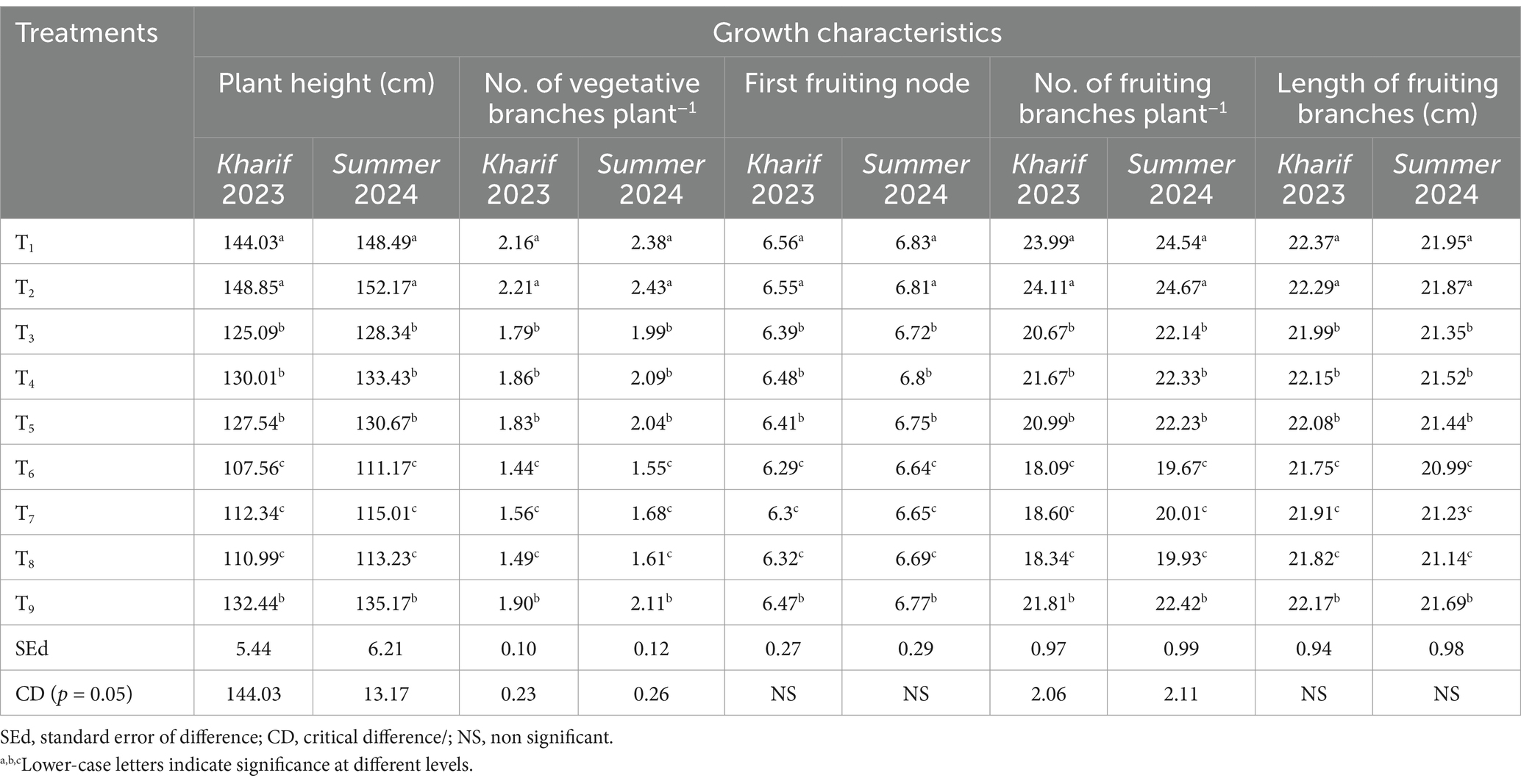
Table 4. Impact of different nutrient management strategies on growth characteristics of coloured cotton in Kharif 2023 and Summer 2024.
Plant height at the maturity stage (150 DAS) exhibited significant variation among the different nutrient management practices (Table 4). The application of 100% NPK based on site-specific recommendation (100:40:30 kg ha−1) (T2) registered the maximum plant height of 148.85 cm and 152.17 cm during Kharif 2023 and Summer 2024, respectively. This performance was statistically comparable to the 100% NPK blanket application (80:40:40 kg ha−1) (T1) resulted plant height of 144.03 cm and 148.49 cm in the respective seasons. This was followed by the complete organic package (132.44 and 135.17 cm), cover crop with vermicompost (130.01 and 133.43 cm) and cover crop with poultry manure (127.54 and 130.67 cm) and all other organic treatments during both seasons.
The number of vegetative branches per plant (NVB plant−1) showed significant statistical variation among the different nutrient application practices of coloured cotton (Table 4). A higher number of vegetative branches per plant (NVB plant−1) was recorded in plots treated with inorganic nutrient management practices including T2—100% NPK based on site-specific (2.21 and 2.43 VB plant−1) and T1—100% NPK through blanket (2.16 and 2.38 VB plant−1) (80:40:40 kg ha−1) recommendations. This was followed by complete organic package (T9) (1.90 and 2.11 VB plant−1), cover crop with vermicompost on N-equivalent basis (T4) (1.86 and 2.09 VB plant−1) and cover crop with poultry manure on N-equivalent basis (1.83 and 2.04 VB plant−1) and all other organic treatments during the same seasons. The first fruiting node did not exhibit significant variation across the nutrient management practices (Table 4).
Fruiting branches are the primary structures that support the crop reproductive organs. Their growth is influenced by agronomic practices including nutrient management strategies. Significant variation in the fruiting branches of coloured cotton were observed under different nutrient management practices. The coloured cotton crop treated with 100% NPK based on site-specific recommendation (24.11 and 24.67 FB plant−1) and blanket recommendation (23.99 and 24.54 FB plant−1) practices recorded the highest number of fruiting branches per plant (NFB plant−1) followed by the complete organic package (T9) (21.81 and 22.42 FB plant−1) cover crop with vermicompost on an N-equivalent basis (T4) (21.67 and 22.33 FB plant−1) and cover crop with poultry manure on an N-equivalent basis (T5) (20.99 and 22.23 FB plant−1) during Kharif 2023 and Summer 2024, respectively. No significant differences were observed in the length of fruiting branches across the different nutrient management practices of coloured cotton (Table 4).
The yield components of coloured cotton including the number of fruiting points per plant (NFP plant−1), number of bolls per plant (NB plant−1), number of bolls per square meter (NB m−2), boll setting percentage (BS%), 10 boll weight (10 BW) and single boll weight (SBW) were significantly affected by different nutrient management strategies (Table 5).
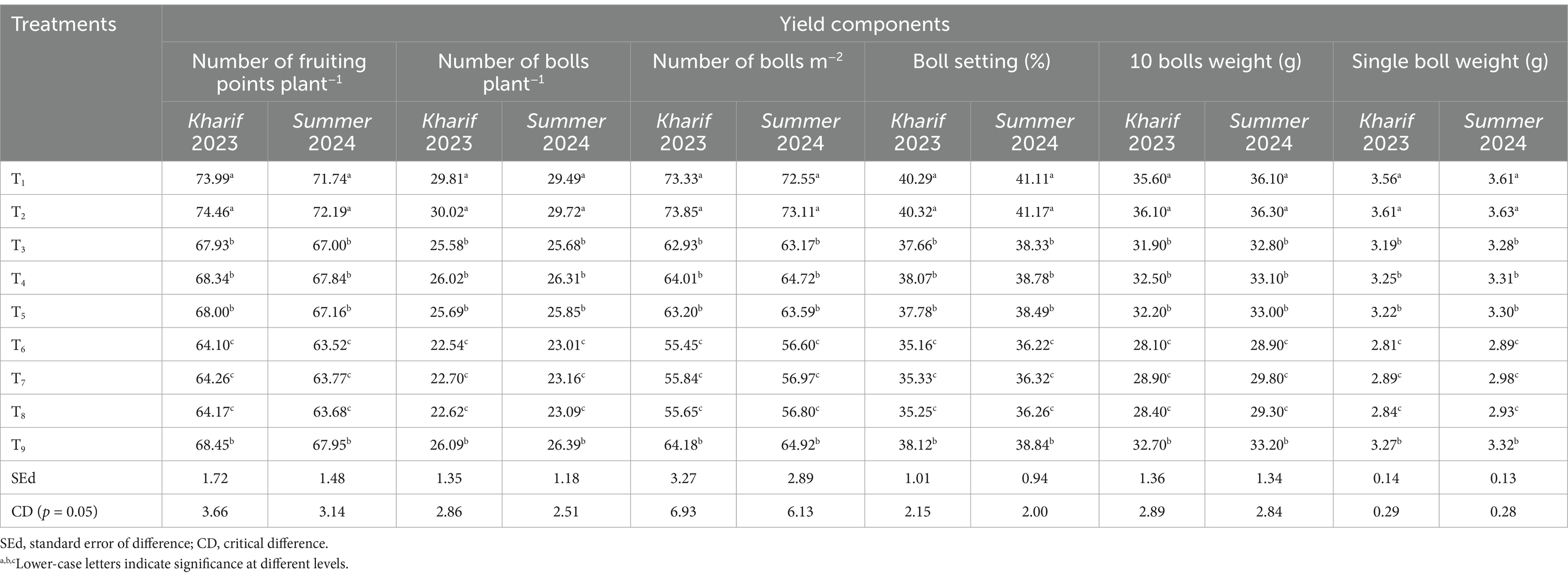
Table 5. Impact of different nutrient management strategies on yield components of coloured cotton in Kharif 2023 and Summer 2024.
The number of fruiting points per plant (NFP plant−1) in coloured cotton was significantly influenced by various nutrient management practices (Table 5). Among the nutrient management practices, the application of 100% NPK based on site-specific recommendation (T2) (74.46 and 72.19 FP plant−1) and blanket recommendation (T1) (73.99 and 71.74 FP plant−1) showed superior performance in terms of the number of fruiting points per plant (NFP plant−1) Kharif 2023 and Summer 2024. These were followed by the complete organic package (T9) (68.45 and 67.95 FP plant−1), cover crop with vermicompost on an N-equivalent basis (T4) (68.34 and 67.84 FP plant−1) and cover crop with poultry manure on an N-equivalent basis (T5) (68.00 and 67.16 FP plant−1) during the first and second seasons.
Boll characteristics is a crucial factor influencing seed cotton yield. Nutrient management practices had a significant impact on boll traits including number of bolls per plant (NB plant−1), boll setting percentage (BS %), 10 boll weight (10 BW) and single boll weight (SBW) in coloured cotton (Table 5). The application of 100% NPK based on site-specific recommendation (100:40:30 kg ha−1) (T2) produced highest number of bolls per plant (30.02 and 29.72 B plant−1) bolls per square meter (73.85 and 73.11 B plant−1), boll setting percentage (40.32 and 41.17%), 10 boll weight (36.10 and 36.30 g) and an average boll weight of 3.61 g and 3.63 g during Kharif 2023 and Summer 2024. This performance was comparable to the 100% NPK blanket application (80:40:40 kg ha−1) (T1). Both inorganic treatments showed comparable impacts, significantly outperforming of complete organic package (T9) and other organic nutrient management treatments in both growing seasons.
Seed cotton yield (SCY), lint cotton yield (LCY), stalk yield (SY) and biological yield (BY) of coloured cotton were significantly influenced by various nutrient management strategies (Table 6 and Figures 3–10).
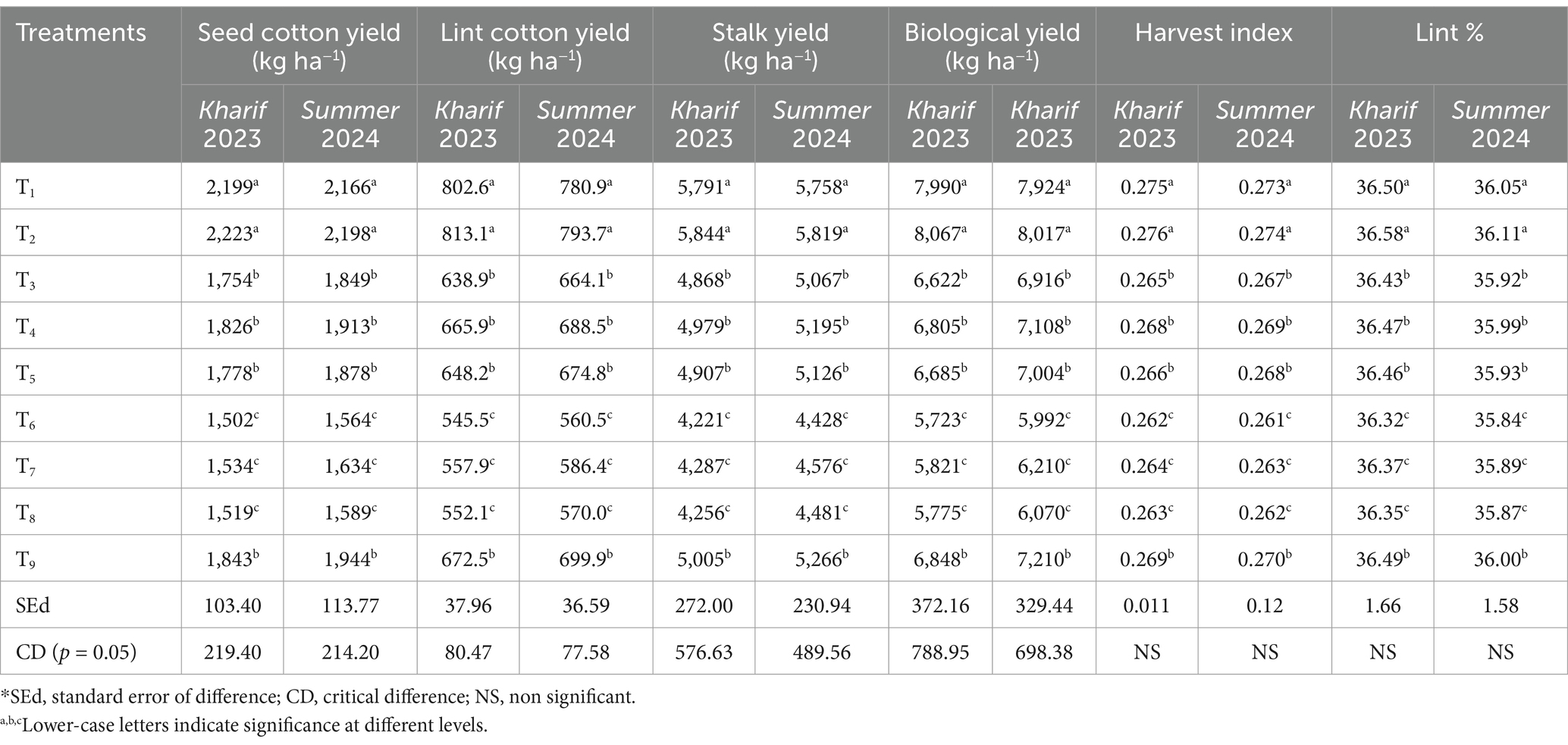
Table 6. Impact of different nutrient management strategies on yield of coloured cotton in Kharif 2023 and Summer 2024.
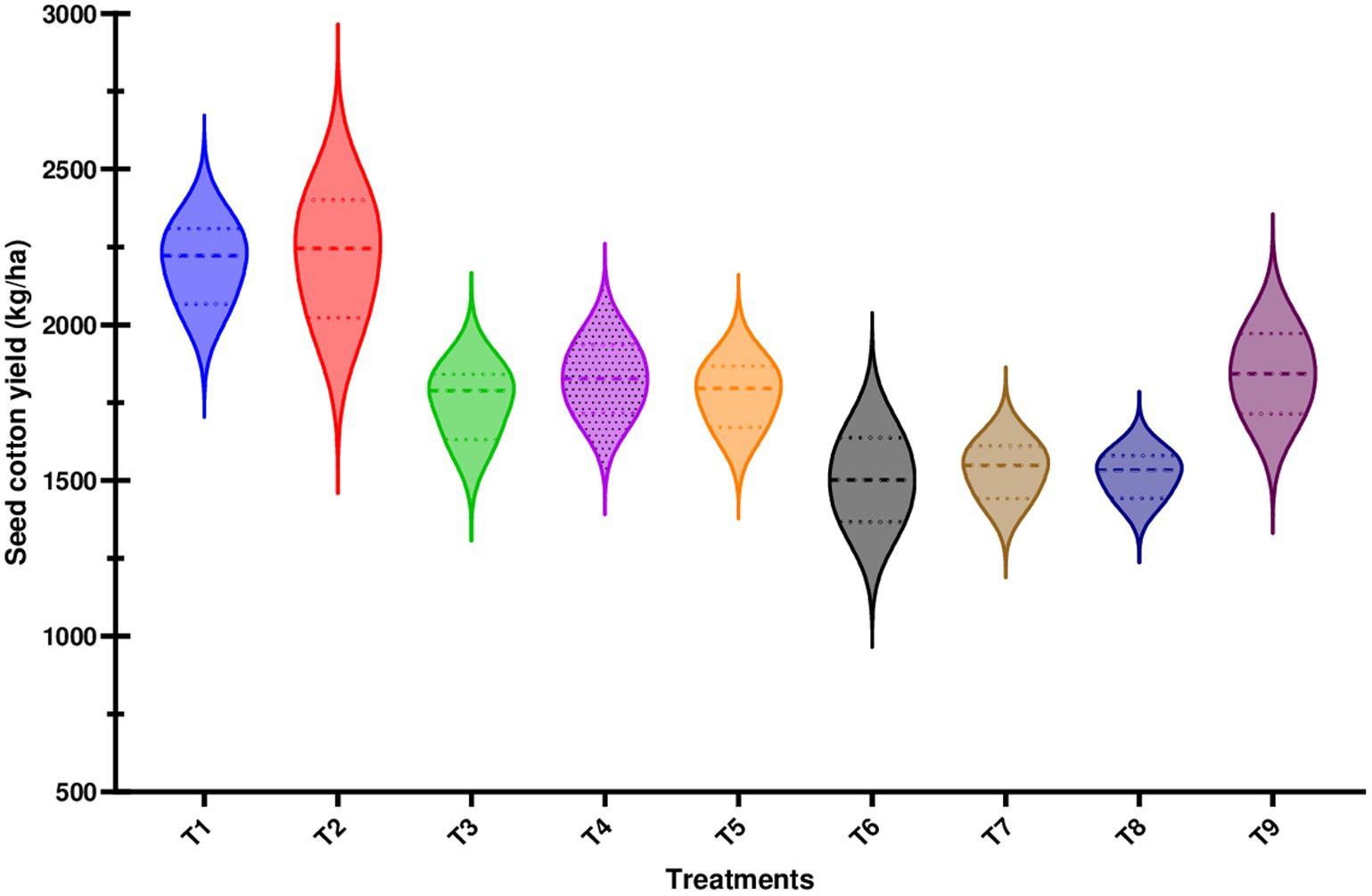
Figure 3. Impact of various nutrient management strategies on seed cotton yield (kg ha−1) of coloured cotton during Kharif 2023.

Figure 4. Impact of various nutrient management strategies on seed cotton yield (kg ha−1) of coloured cotton during Summer 2024.
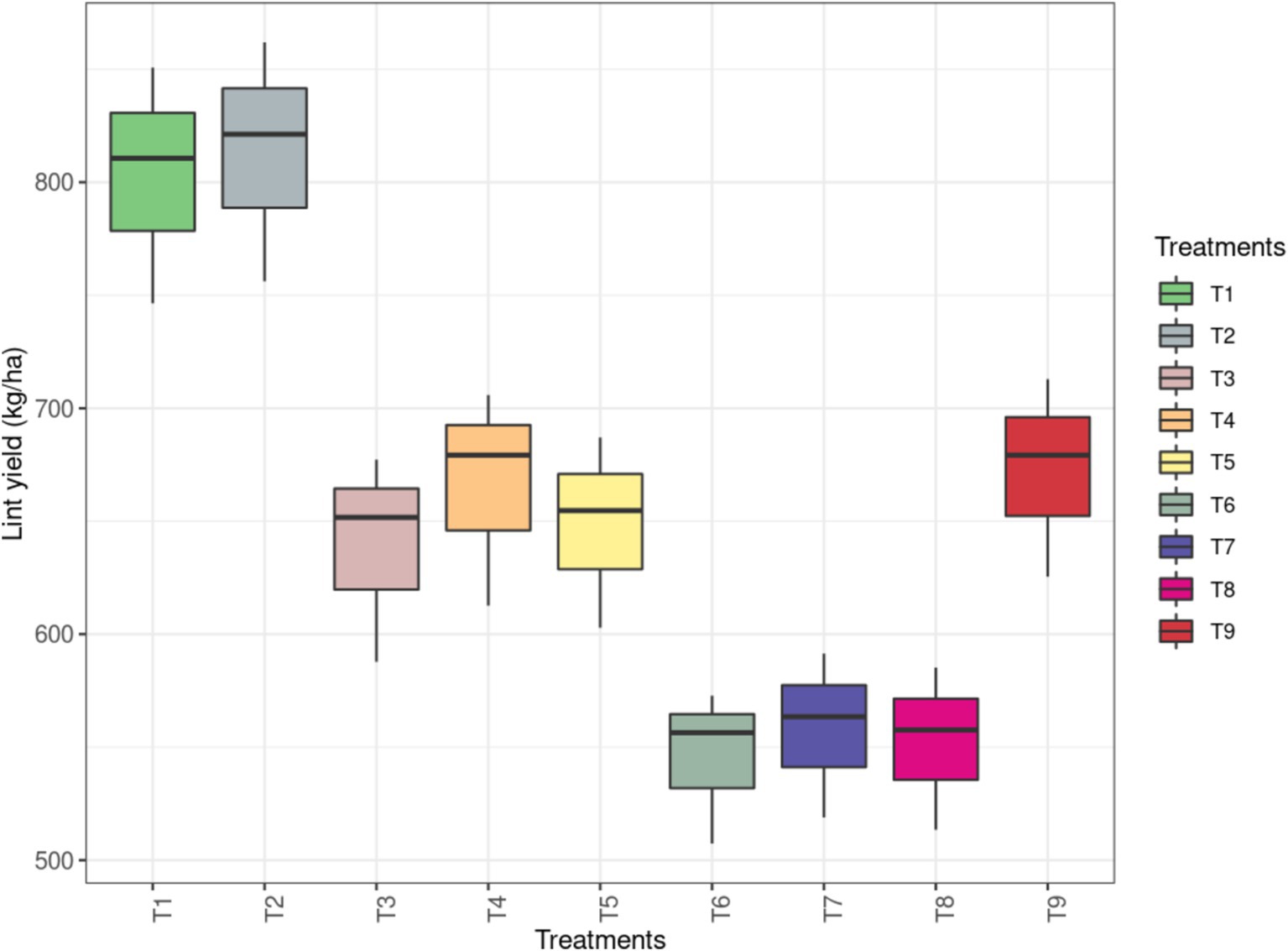
Figure 5. Impact of various nutrient management strategies on lint cotton yield (kg ha−1) of coloured cotton during Kharif 2023.
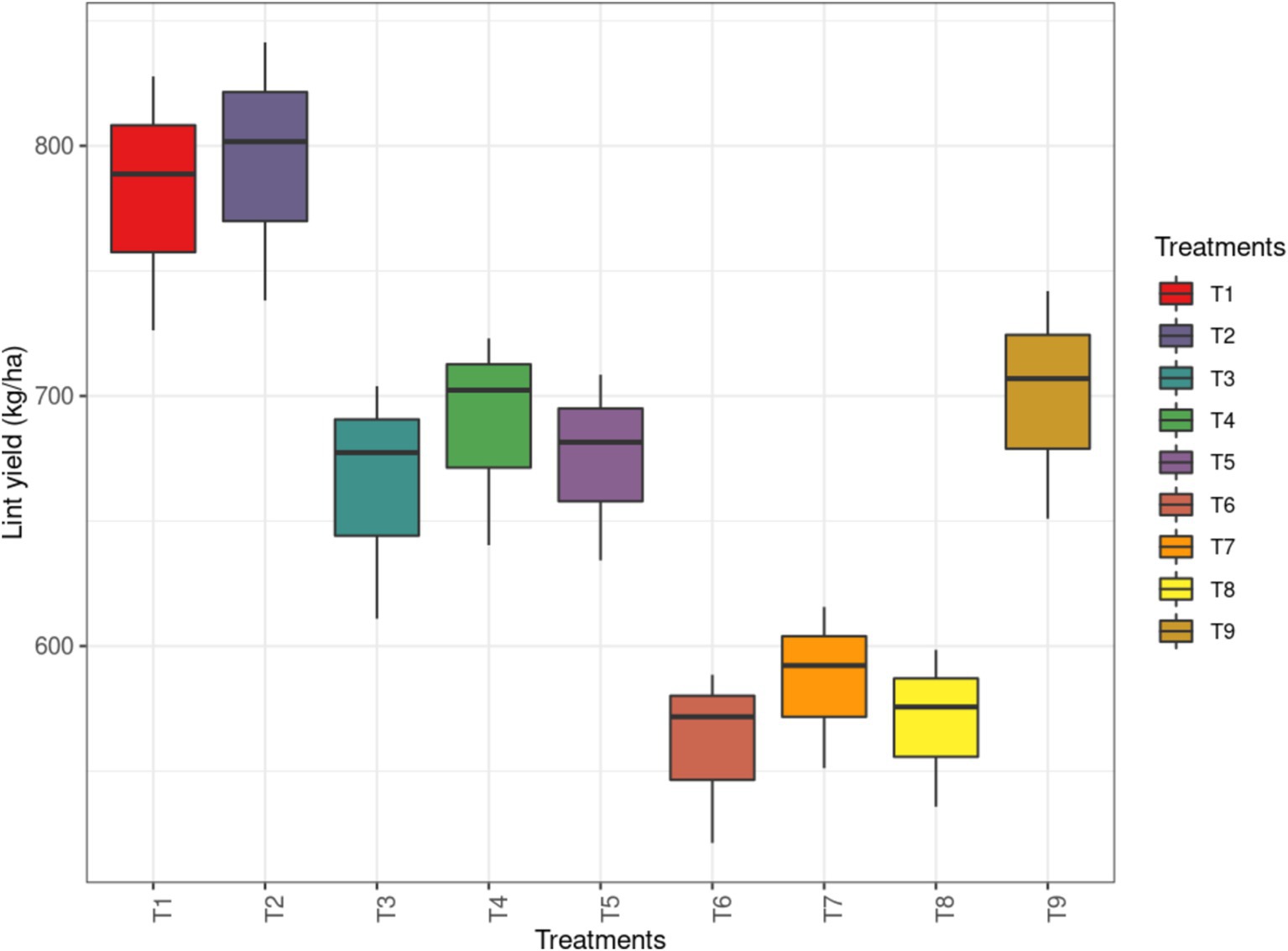
Figure 6. Impact of various nutrient management strategies on lint cotton yield (kg ha−1) of coloured cotton during Summer 2024.
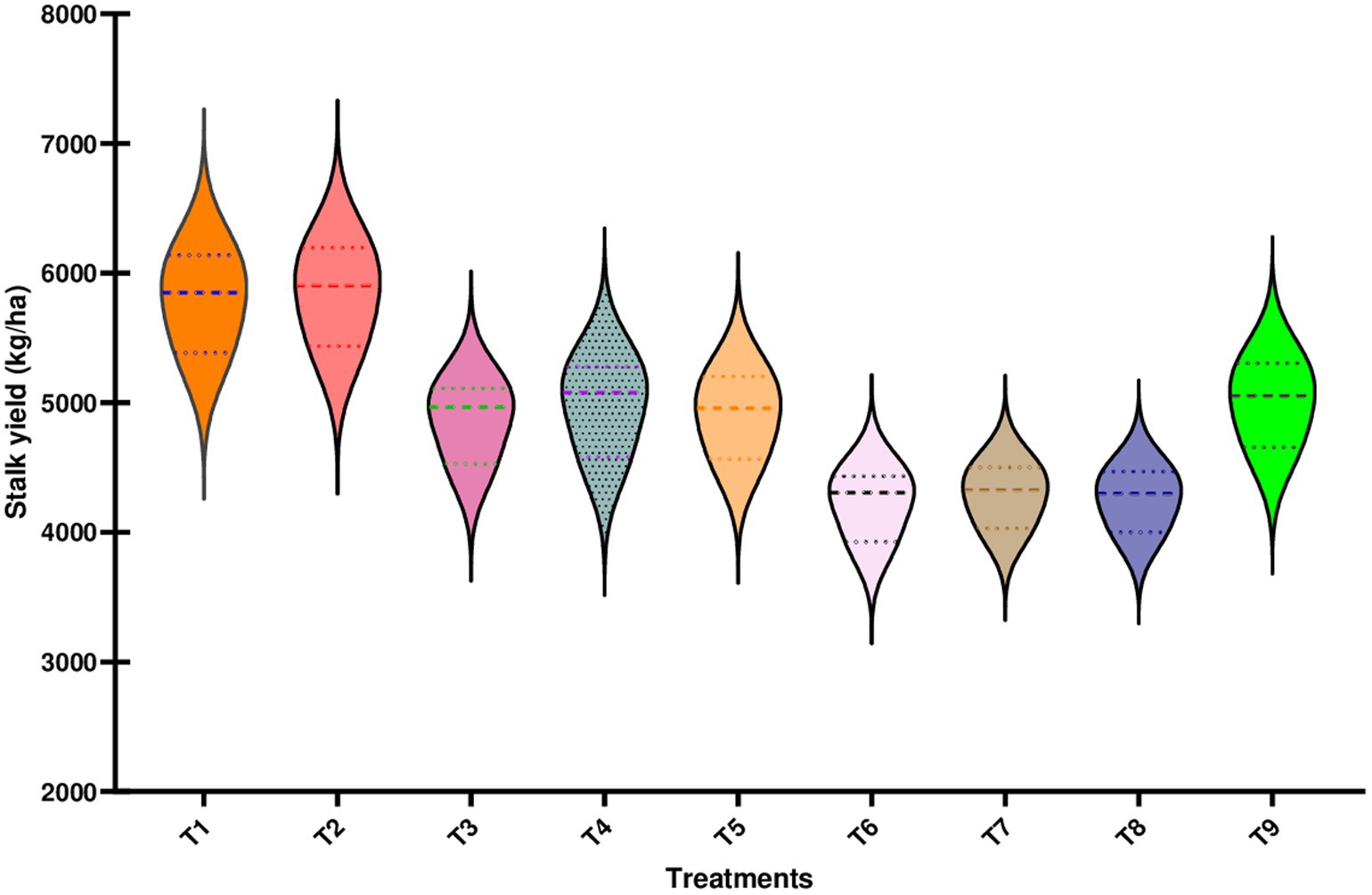
Figure 7. Impact of various nutrient management strategies on stalk yield (kg ha−1) of coloured cotton during Kharif 2023.
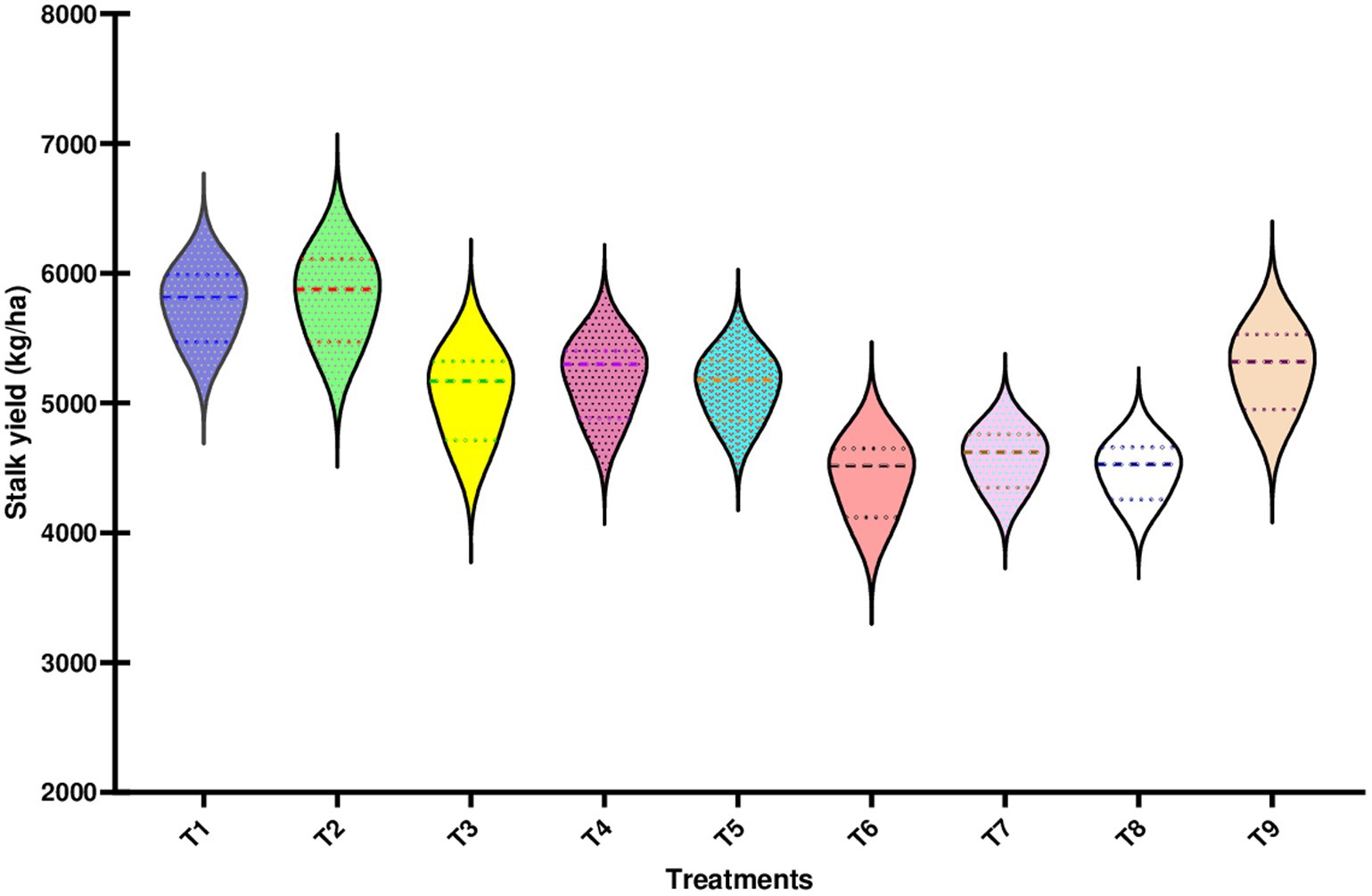
Figure 8. Impact of various nutrient management strategies on stalk yield (kg ha−1) of coloured cotton during Summer 2024.
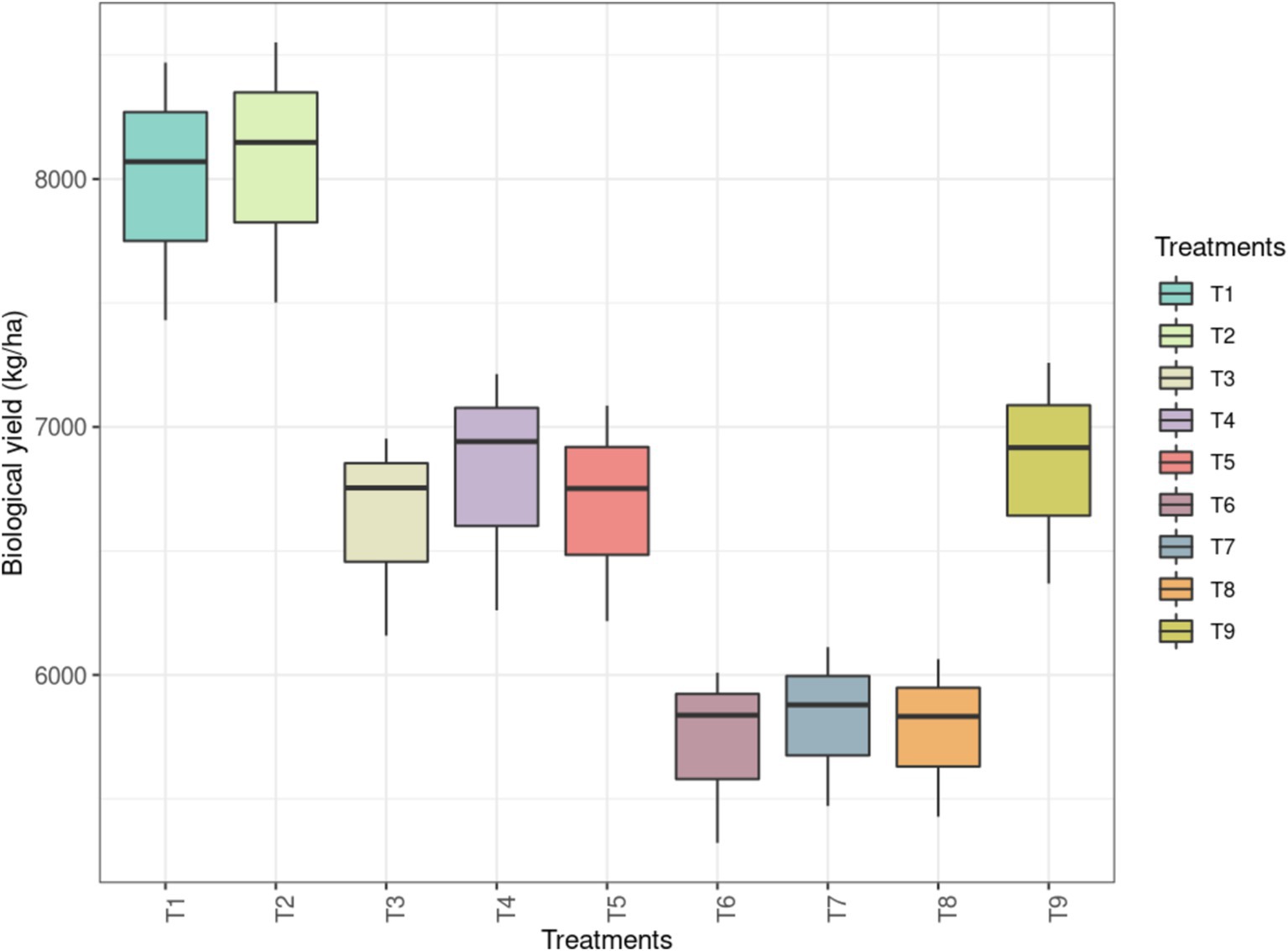
Figure 9. Impact of various nutrient management strategies on biological yield (kg ha−1) of coloured cotton during Kharif 2023.
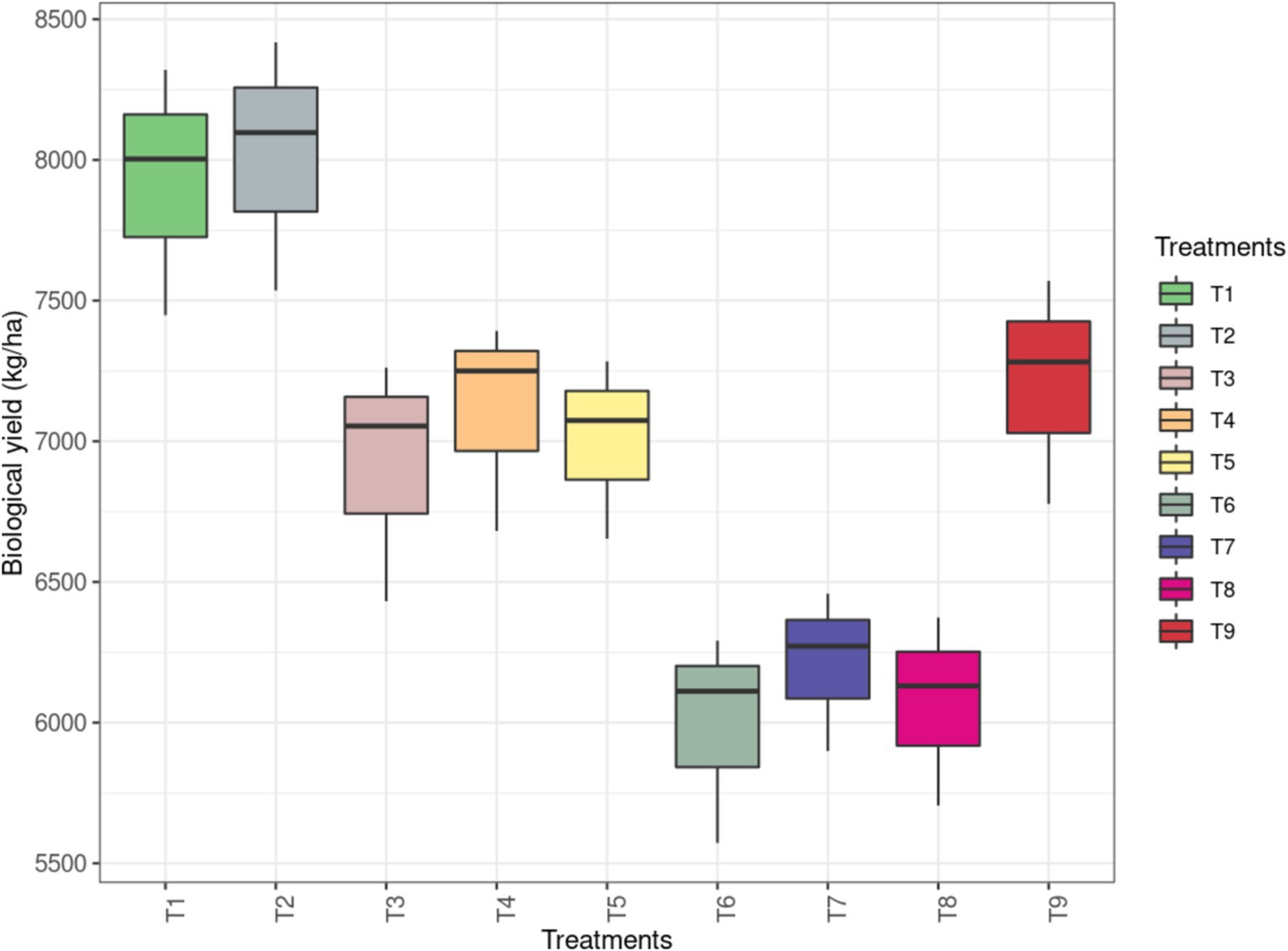
Figure 10. Impact of various nutrient management strategies on biological yield (kg ha−1) of coloured cotton during Summer 2024.
Seed cotton yield (SCY) and lint cotton yield (LCY) of coloured cotton were notably affected by various nutrient management practices (Table 6 and Figures 3–6). The application of 100% NPK based on site-specific recommendation (100:40:30 kg ha−1) (T2) achieved the highest seed cotton yield (2,223 and 2,198 kg ha−1) and lint cotton yield (813.1 and 793.7 kg ha−1) during Kharif 2023 and Summer 2024, respectively. These results were statistically similar to those obtained with the application of 100% NPK based on blanket recommendation (80:40:40 kg ha−1) (T1). They were followed by the complete organic package (T9) producing SCY (1,843 and 1,944 kg ha−1) and LCY (672.5 and 699.9 kg ha−1) outperforming other organic treatments in both seasons.
The stalk yield (SY) was significantly affected by different nutrient management approaches (Table 6 and Figures 7, 8). The highest stalk yield (5,844 and 5,791 kg ha−1) in Kharif 2023 and (5,819 and 5,758 kg ha−1) in Summer 2024 was recorded with inorganic treatments including 100% NPK based on site-specific (100:40:30 kg ha−1) (T2) and blanket (80:40:40 kg ha−1) (T1) recommendations. The next highest yield was observed with the complete organic package (T9) (5,005 and 5,266 kg ha−1) followed by cover crop with vermicompost (T4) (4,979 and 5,195 kg ha−1) and cover crop with poultry manure (T5) (4,907 and 5,126 kg ha−1) along with all other organic treatments during both Kharif 2023 and Summer 2024.
Biological yield (BY) was significantly influenced by various nutrient management practices (Table 6 and Figures 9, 10). Among the nutrient management practices, the application of 100% NPK based on site-specific recommendation (T2) (8,067 and 8,017 kg ha−1) and blanket recommendation (T1) (7,990 and 7,924 kg ha−1) showed superior performance in terms of the biological yield (BY) during Kharif 2023 and Summer 2024. These were followed by the complete organic package (T9) (6,848 and 7,210 kg ha−1), cover crop with vermicompost on an N-equivalent basis (T4) (6,805 and 7,108 kg ha−1) and cover crop with poultry manure on an N-equivalent basis (T5) (6,685 and 7,004 kg ha−1) in the respective seasons. No significant variations were observed in the harvest index (HI) and lint percentage (L %) across the different nutrient management practices of coloured cotton (Table 6).
Positive correlation was observed among the studied morphological and yield traits of coloured cotton under various nutrient management strategies (Figure 11). Significant positive relationships were recorded between plant height (PH), number of vegetative branches plant−1 (NVB/plant), number of fruiting branches plant−1 (NFB/plant), number of fruiting points plant−1 (NFP/plant), Number of bolls plant−1 (NB/plant), number of bolls m−2 (NB/sq. m), boll setting percentage (BS%), boll weight (BW), seed cotton yield (SCY) and lint cotton yield (LCY) across different nutrient management strategies. The seed cotton yield of coloured cotton exhibited a strong positive correlation and a highly significant association with morphological and yield traits such as NFP/plant (0.69), NB/sq. m (0.69), NB/plant (0.68), BW (0.65), NFB/plant (0.65), PH (0.64), NVB/plant (0.64) and BS% (0.64) under diverse nutrient management approaches. Likewise, lint cotton yield (LCY) in coloured cotton showed a strong positive correlation with various morphological and yield traits including NFP/plant (0.70), NB/sq. m (0.70), NB/plant (0.68), BW (0.66), BS% (0.66), NVB/plant (0.65), NFB/plant (0.65) and PH (0.64) at various nutrient management strategies. Similar results were observed by Ibrahim et al. (2022).

Figure 11. Pearson’s correlation coefficients depicting the associations among 10 growth and yield attributes of coloured cotton under diverse nutrient management strategies (combined analysis of two consecutive seasons of Kharif 2023 and Summer 2024). PH, plant height; NVB/plant, number of vegetative branches plant−1; NFB/plant, number of fruiting branches plant−1; NFP/plant, number of fruiting points plant−1; NB/plant, number of bolls plant−1; NB/sq. m, number of bolls m−2; BS%, boll setting percentage; BW, boll weight; SCY, seed cotton yield; LCY, lint cotton yield. Positive correlation is shown by black.
The observed strong positive correlation between morphological and yield traits and both seed and lint cotton yields can be explained by the direct influence of these traits on cotton productivity. Traits such as number of flowers per plant (NFP/plant), number of bolls per square meter (NB/sq. m), boll weight (BW) and boll size percentage (BS%) are key contributors to boll formation and seed cotton yield. An increase in these traits directly increases the number and size of bolls, which results in higher seed cotton yields.
Similarly, traits like plant height (PH) and number of vegetative branches (NVB/plant) play a significant role in photosynthesis and nutrient absorption, which promote better plant growth and productivity. The positive correlation between these traits and lint cotton yield (LCY) is due to the fact that higher boll formation and boll size contribute to more fibre production. Additionally, under diverse nutrient management practices, these traits respond positively, thereby further enhancing yield. These correlations indicate that selecting plants with optimal morphological traits and managing nutrient inputs effectively can result in improved seed and lint yields.
The hierarchical clustering clearly distinguished the interrelationship between combinations of different nutrient management strategies (six combinations) according to their performance of yield traits (Figure 12). As regards the relationship between different nutrient management treatments, two main clusters were characterized. The first cluster was formed by the combination’s treatments of T2 (100% NPK based on site specific recommendation) and T1 (100% NPK through blanket recommendation) in this group, these two treatments provided the highest values for all the yield traits. The second cluster is divided into two subclusters, the first subclusters was formed by the combinations of T9 (complete organic package), T4 (cover crop + 75% N through vermicompost), T5 (cover crop + 75% N through poultry manure) and T3 (cover crop + 75% N through farm yard manure) whereas, the treatments T9 and T4, were the closest sub-clusters. For treatments T9 and T4 also showed the positive effects on all the yield traits under various nutrient management. The treatments T5 and T3 showed slightly negative of majority of traits except for the BW and BS%. The second sub-cluster included each of the treatment T7 (green manure + 75% N through vermicompost), T8 (green manure + 75% N through poultry manure) and T6 (green manure + 75% N through farm yard manure), whereas the treatments T7, T8, and T6 were the closest sub-clusters. The nutrient management treatments in the second sub-cluster (including T7, T8, and T6) exhibited an opposite pattern compared to the first cluster. All yield traits were negatively impacted, resulting in lower overall performance across all studied traits.

Figure 12. Clustering analysis presents the relationships between different nutrient management strategies and yield traits. The heatmap visualizes hierarchical clustering results, where Euclidean distance was used to compute the similarity between data points based on their principal component scores. Ward’s linkage method was employed for clustering, ensuring that the variance within clusters is minimized. The dendrograms at the top and left show the grouping of variables, highlighting patterns and relationships among them. NFP/P, number of fruiting points plant−1; NB/P, number of bolls plant−1; NB/m2, number of bolls m−2; BW, boll weight; BS %, boll setting percentage; SCY, seed cotton yield; LCY, lint cotton yield.
Coloured cotton plants were relatively taller in the application of inorganic nutrients (100% NPK through site-specific and blanket recommendations) compared to the other organic nutrient treatments like complete organic package, cover crop with vermicompost, cover crop with poultry manure and cover crop with farm yard manure (Table 4).
Inorganic nutrient treatments like 100% NPK through site-specific and blanket recommendations, significantly improved growth parameters such as plant height, first fruiting note, vegetative branches, fruiting branches and length of fruiting branch. This improvement might be due to the immediate and balanced nutrient supply with nitrogen promoting vegetative growth, phosphorus supporting root and branch development and potassium enhancing cell elongation and overall plant vigour. These findings are reported to be similar to Muthukrishnan et al. (2017), Ravikiran and Halepyati (2019), Parmar et al. (2019), and Aruna et al. (2020).
Compared to inorganic nutrients, organic management practices like the complete organic package (cover crop + vermicompost + biofertilizers + biocontrol agents + PPFM) and cover crop with vermicompost showed a slower but steady improvement in growth parameters including plant height, vegetative branches, fruiting branches and branch length. This might be due to the gradual nutrient release from organic inputs, enhancing soil organic matter, microbial activity and soil health over time. Vermicompost provided sustained nutrient availability, biofertilizers improved nitrogen fixation and phosphorus solubilization and PPFM boosted plant metabolism and stress tolerance. While initial growth under organic treatments lagged, their cumulative benefits promoted sustainable and balanced plant development over time (Gaikwad et al., 2020; Subramanian et al., 2020; Tinku et al., 2024).
The yield components of coloured cotton such as the number of fruiting points, number of bolls plant−1, boll weight and boll setting percentage play a critical role in determining seed cotton yield. The application of 100% NPK through site-specific and blanket recommendations significantly improved these attributes due to the rapid and balanced availability of essential nutrients required for optimal growth and reproductive development.
Adequate nitrogen availability in inorganic nutrients (100% NPK) might have promoted both vegetative and reproductive growth, fostering the formation of fruiting points and creating more sites for boll development. A well-balanced phosphorus supply might have been crucial for boll initiation and retention, as it facilitated energy transfer in the plant and reduced boll shedding. This likely resulted in a higher number of bolls, ultimately improving seed cotton yield of cotton. Potassium might have played a significant role in carbohydrate translocation, leading to larger and heavier bolls, which ultimately enhanced yield per plant and overall crop productivity. Our results were in line with Vinodakumar et al. (2012), Islam et al. (2014), and Meena et al. (2019). The balanced nutrient supply from 100% NPK might have minimized flower and fruit drop by reducing physiological stress. This leads to an increased boll setting percentage resulting in a greater number of bolls per plant and enhanced the cotton productivity.
On the other hand, organic nutrient management treatments such as the complete organic package (cover crop + vermicompost + biofertilizers + biocontrol agents + PPFM) and cover crop with vermicompost, exhibited promising effects on yield attributes like the number of fruiting points per plant, number of bolls per plant, boll weight and boll setting percentage. This could be attributed to the gradual and sustained nutrient release from organic sources, which likely improved soil health, enhanced microbial activity and strengthened nutrient cycling over time. These findings are found to be similar to Pandiselvi and Manoharan (2015) and Tinku et al. (2024).
The combination of organic manures, biofertilizers and biocontrol agents might be due to their ability to provide a balanced nutrient supply while enhancing the physical and biological properties of the soil. This could have fostered pest and disease resistance and improved nutrient uptake efficiency, contributing to an increase in fruiting points and better boll retention (Channagouda et al., 2015; Pulatov et al., 2016). The addition of PPFM (pink pigmented facultative methylotrophs) might have enhanced plant physiological processes, supporting boll development under stress conditions (Gaikwad et al., 2020). Likewise, the combination of cover crops with vermicompost might be attributed to its role in enriching soil organic matter and stimulating microbial activity, which promoted better root development and the gradual formation of fruiting points. Over time, this approach might have contributed to increased boll weight due to the steady supply of essential nutrients and improved soil moisture retention. The results were similar to those reported by Sui and Anapalli (2021), Kornecki et al. (2015), and McDonald et al. (2020). Although the initial performance of organic treatments was lower than that of inorganic nutrients, the long-term benefits of these practices on soil fertility and plant health might have positively influenced yield parameters and yield, making organic packages a sustainable option for cotton production.
In this study, the higher seed cotton yields observed with inorganic fertilizers might be due to their rapid nutrient release, which supported immediate crop growth and yield. Organic manures, while slower in nutrient availability, gradually improved soil health, nutrient cycling and sustainability offering long-term benefits for productivity (Maurya et al., 2008; Gudadhe et al., 2013; Ramesh et al., 2017).
Similarly, inorganic nutrients significantly enhanced lint yield, lint percentage, stalk yield and biological yield. This might be attributed to the immediate and consistent supply of essential nutrients necessary for fibre development and biomass accumulation. The availability of key nutrients during critical stages of fibre elongation and thickening might have improved both the quality and quantity of lint. Additionally, the higher straw and biological yields could be linked to the efficient nutrient uptake facilitated by inorganic sources, which ensured optimal vegetative and reproductive growth. On the other hand, organic manures releasing nutrients more gradually might have contributed to long-term improvements in soil health, nutrient availability and microbial activity indirectly supporting fibre growth and biomass production in subsequent seasons. The use of recommended doses of nitrogen through cover crop with organic manures resulted in lower yields compared to 100% NPK (site-specific and blanket applications) might be due to the slower nutrient release from organic sources. This might have limited the immediate availability of nitrogen, phosphorus and potassium (NPK) required by the cotton crop, particularly during the early growth stages. These findings were similar to Nagavani (2010) and Kshirsagar et al. (2024).
In the first season (Kharif 2023), reductions in seed cotton yield (17.09 to 32.43%) and lint cotton yield (17.29 to 32.91%) were observed under organic nutrient management (T3 to T9) compared to inorganic site-specific (T2) and blanket (T1) recommendations. However, by the second season these yield reductions decreased to 11.56 to 28.84% for seed cotton yield and 11.82 to 29.38% for lint cotton yield indicating a narrowing of the yield gap. This improvement might be due to the gradual and sustained nutrient release from organic manures over time (Muthukrishnan et al., 2017).
Inorganic nutrients such as 100% NPK (site-specific and blanket recommendations) offer rapid nutrient availability, facilitating immediate nutrient uptake during early cotton growth and resulting in higher initial yields, which are beneficial for short-term yield optimization. On the other hand, organic amendments including cover crops, vermicompost and poultry manure release nutrients gradually, which leads to lower initial yields. However, organic nutrients improve soil structure, stimulate microbial activity, enhance nutrient cycling and boost water retention, thereby contributing to long-term soil fertility and sustainable cotton production with gradually increasing yields over successive growing seasons. These findings are reported to be similar to Chandramohan and Chandaragiri (2007), Channabasana et al. (2008), Arora et al. (2011), Mohadeseh et al. (2015), and Subramanian et al. (2020).
In conclusion, this study revealed that nutrient management strategies significantly influenced the growth, yield components and productivity of coloured cotton. Over two seasons (Kharif 2023 and Summer 2024), inorganic treatments particularly 100% NPK based on site-specific (T2) and blanket (T1) recommendations achieved the highest short-term yields and fibre quality. However, these approaches raise concerns regarding long-term sustainability, including soil health degradation. In contrast, organic treatments such as the complete organic package (T9) and cover crop with vermicompost (T4) enhanced soil fertility, conserved water and reduced chemical inputs, promoting environmental sustainability. Although organic practices initially resulted in slightly lower yields, they improved over time to match the performance of inorganic methods in terms of both yield and fibre quality. Notably, fibre quality in coloured cotton is primarily governed by genetics with limited influence from nutrient management. Therefore, integrating organic practices not only ensures sustainable cotton production and fibre quality but also supports soil health, water conservation and reduced environmental impacts, making T9 and T4 suitable long-term strategies for farmers aiming to balance productivity with sustainability.
The datasets presented in this study can be found in online repositories. The names of the repository/repositories and accession number(s) can be found in the article/supplementary material.
SS: Conceptualization, Data curation, Formal analysis, Funding acquisition, Methodology, Software, Writing – original draft, Writing – review & editing. TR: Conceptualization, Data curation, Investigation, Methodology, Resources, Supervision, Validation, Visualization, Writing – original draft, Writing – review & editing. AG: Investigation, Methodology, Writing – original draft, Writing – review & editing. JP: Conceptualization, Data curation, Investigation, Writing – original draft, Writing – review & editing. MG: Conceptualization, Data curation, Investigation, Methodology, Writing – original draft, Writing – review & editing. TS: Writing – original draft, Writing – review & editing. ES: Resources, Writing – original draft, Writing – review & editing. SR: Writing – review & editing. BA: Writing – review & editing. AS: Writing – review & editing. SH: Writing – review & editing.
The author(s) declare that no financial support was received for the research, authorship, and/or publication of this article.
The authors would like to acknowledge the advisory committee members, teaching and non-teaching staff members of the Department of Agronomy for their assistance during this study.
The authors declare that the research was conducted in the absence of any commercial or financial relationships that could be construed as a potential conflict of interest.
The authors declare that no Gen AI was used in the creation of this manuscript.
All claims expressed in this article are solely those of the authors and do not necessarily represent those of their affiliated organizations, or those of the publisher, the editors and the reviewers. Any product that may be evaluated in this article, or claim that may be made by its manufacturer, is not guaranteed or endorsed by the publisher.
AICRIP (2024). “ICAR-AICRP (cotton) annual report (2023–2024)” in ICAR—All India coordinated research project on cotton (Nagpur: Central Institute for Cotton Research), 1–2.
Ali, M. A., Farooq, J., Batool, A., Zahoor, A., Azeem, F., Mahmood, A., et al. (2019). “Cotton production in Pakistan” in Cotton production (Hoboken, NJ: Wiley Blackwell), 249–276.
Arora, V. K., Singh, C. B., Sidhu, A. S., and Thind, S. S. (2011). Irrigation, tillage, and mulching effects on soybean yield and water productivity in relation to soil texture. Agric. Water Manag. 98, 563–568. doi: 10.1016/j.agwat.2010.10.004
Aruna, B., Bhat, S. N., Balanagoudar, S. R., Vishwanath, J., and Anand, N. (2020). Influence of different nutrient management approaches on growth and yield of Bt cotton in a vertisol. Int. J. Chem. Stud. 8, 2859–2863. doi: 10.22271/chemi.2020.v8.i1aq.8703
Chandramohan, S., and Chandaragiri, K. K. (2007). Effect of organic manures on growth and yield attributes in cotton + blackgram intercropping system. Int. J. Plant Sci. 2, 156–160.
Channabasana, G. C., Patil, N. K., Patil, B. N., Awaknavar, J. S., Ninganur, B. T., and Hunje, R. H. (2008). Effect of organic manures on growth, seed yield, and quality of wheat. Karnataka J. Agric. Sci. 21, 366–368. doi: 10.5555/20083314854
Channagouda, R. F., Babalad, H. B., and Dineshkumar, S. P. (2015). Effect of organic manures, green leaf manures, liquid organic manures, and micronutrients on yield and economics of cotton (Gossypium spp.). Indian J. Agric. Sci. 85, 1273–1278. doi: 10.56093/ijas.v85i10.52247
Chockalingam, M. M. (2020). “Colour cotton—an overview” in A profile of Indian cotton: at a glance, 5–6.
CPG (2020). Crop production guide—agriculture. Coimbatore: Directorate of Agriculture, Chennai, and Tamil Nadu Agricultural University.
Dhamodharan, P., Somasundaram, S., Thirukumaran, K., Kavitha, R., Ravichandran, V., and Anantharaju, P. (2024). Exogenous application of mepiquat chloride and crop geometry alters cotton growth and yield traits of compact cotton cultivars (Gossypium hirsutum L.). Plant Sci. Today 11, 01–11. doi: 10.14719/pst.4976
Donald, C. M., and Hamblin, J. (1976). The biological yield and harvest index of cereals as agronomic and plant breeding criteria. Adv. Agron. 28, 361–405. doi: 10.1016/S0065-2113(08)60559-3
Gaikwad, G. S., Paslawar, A. N., Bhale, V. M., Parlawar, N. D., Rathod, T. H., Deshmukh, M. R., et al. (2020). Effect of different organic sources and PGR on growth and chlorophyll content in organic cotton under rainfed condition. Int. J. Chem. Stud. 8, 3405–3408. doi: 10.22271/chemi.2020.v8.i4aq.10177
Gomez, K. A., and Gomez, A. A. (2010). Statistical procedures for agricultural research. 3rd Edn. New York: John Wiley and Sons.
Gudadhe, N. N., Kumar, N., Pisal, R. R., Mote, B. M., and Dhonde, M. B. (2013). Evaluation of agrometeorological indices in relation to crop phenology of cotton (Gossypium spp.) and chickpea (Cicer arietinum L.). Trends Biosci. 6, 246–250.
Ibrahim, I. A., Yehia, W. M., Saleh, F. H., Lamlom, S. F., Ghareeb, R. Y., et al. (2022). Impact of plant spacing and nitrogen rates on growth characteristics and yield attributes of Egyptian cotton (Gossypium barbadense L.). Front. Plant Sci. 13:916734. doi: 10.3389/fpls.2022.916734
Iqbal, A., Qiang, D., Zhun, W., Xiangru, W., Huiping, G., Hengheng, Z., et al. (2020). Growth and nitrogen metabolism are associated with nitrogen-use efficiency in cotton genotypes. Plant Physiol. Biochem. 149, 61–74. doi: 10.1016/j.plaphy.2020.02.002
Islam, M. K., Khalequzzaman, K., and Kaikobad, M. (2014). Effect of organic and inorganic sources of N on cotton yield. Ann. Res. Rev., 131–142. doi: 10.13140/2.1.2311.9362
Jan, M., Hussain, S., Anwar-ul-Haq, M., Iqbal, J., Ahmad, I., Aslam, M., et al. (2020). Effect of farm yard manure and compost application on transgenic Bt cotton varieties. Pak. J. Agric. Res. 33, 371–380. doi: 10.17582/journal.pjar/2020/33.2.371.380
Keshamma, E. (2022). An overview on colour cotton research - a review. Int. J. Eng. Technol. Manag. Sci. 6, 272–278. doi: 10.46647/ijetms.2022.v06i05.040
Khan, A., Tan, D. K. Y., Munsif, F., Afridi, M. Z., Shah, F., Wei, F., et al. (2017). Nitrogen nutrition in cotton and control strategies for greenhouse gas emissions: a review. Environ. Sci. Pollut. Res. 24, 23471–23487. doi: 10.1007/s11356-017-0131-y
Kornecki, T. S., Price, A. J., and Balkcom, K. S. (2015). Cotton population and yield following different cover crops and termination practices in an Alabama no-till system. J. Cotton Sci. 19, 375–386. doi: 10.56454/LAHI9068
Kshirsagar, A. G., Charjan, Y. D., Wankhade, R. S., and Nage, S. M. (2024). Organic nutrient management in color cotton. Int. J. Adv. Biochem. Res. 8, 807–813. doi: 10.33545/26174693.2024.v8.i7Sk.1650
Kumar, R., Pareek, N. K., Kumar, U., Javed, T., Al-Huqail, A. A., Rathore, V. S., et al. (2022). Coupling effects of nitrogen and irrigation levels on growth attributes, nitrogen use efficiency, and economics of cotton. Front. Plant Sci. 13:890181. doi: 10.3389/fpls.2022.890181
Laghari, A. H., Muhammad, J., Chang, M. S., Hakro, S. A., Vistro, R., Mastoi, S. M., et al. (2024). Effect of organic manure and foliar application of boron on morphological and economic parameters of Sindh-1 and CKC-3 cultivars of cotton under semi-arid climate. J. Appl. Res. Plant Sci. 5, 19–26. doi: 10.38211/joarps.2024.05.01.114
Liu, Q., Llewellyn, D. J., Singh, S. P., and Green, A. G. (2012). “Cotton seed development: opportunities to add value to a byproduct of fibre production” in Flowering and fruiting in cotton, 131–162.
Ludemann, C. I., Gruere, A., Heffer, P., and Dobermann, A. (2022). Global data on fertilizer use by crop and by country. Sci. Data 9, 501–508. doi: 10.1038/s41597-022-01592-z
Maurya, A. K., Singh, M. P., Srivastava, B. K., Singh, Y. V., Singh, D. K., Singh, S., et al. (2008). Effect of organic manures and inorganic fertilizers on growth, yield, and economics of sprouting broccoli cv. Fiesta. Indian J. Hortic. 65, 116–118. doi: 10.9734/ijecc/2023/v13i92682
McDonald, M. D., Lewis, K. L., and Ritchie, G. L. (2020). Short-term cotton lint yield improvement with cover crop and no-tillage implementation. Agronomy 10:994. doi: 10.3390/agronomy10070994
Meena, M. K., Meena, R. N., Meena, B. R., Meena, A. K., and Singh, Y. V. (2019). Effect of land management options and manurial application on growth, yield, quality, and nutrient uptake of American cotton (Gossypium hirsutum L.). J. Pharmacogn. Phytochem. 8, 549–554.
Mohadeseh, V. N., Hamid, R. M., and Hamid, R. G. (2015). Effect of different levels of vermicompost on yield and quality of maize varieties. Biol. Forum Int. J. 7, 856–860.
Muthukrishnan, P., Thavaprakaash, N., and Srinivasan, K. (2017). Effect of organic nutrient management practices in comparison with conventional method on performance of cotton in Tamil Nadu. Madras Agric. J. 104, 15–22. doi: 10.29321/MAJ.01.000391
Nagavani, A. V. (2010). “Effect of integrated nutrient management practices on soil fertility and productivity of maize” in PhD thesis (Coimbatore: Tamil Nadu Agricultural University).
Naoumkina, M., Hinchliffe, D. J., and Thyssen, G. N. (2024). Naturally coloured cotton for wearable applications. Front. Plant Sci. 15:1350405. doi: 10.3389/fpls.2024.1350405
Olsen, S., Cole, C., and Watanabe, F. (1954). Estimation of available phosphorus in soils by extraction with sodium bicarbonate. USDA Circular No. 939. Washington DC: US Government Printing Office, 1–43.
Pandiselvi, T., and Manoharan, S. (2015). Yield and NPK uptake of cotton in response to different nutrient management practices. Trends Biosci. 8, 102–105.
Parmar, R. M., Parmar, K. B., and Jadeja, A. S. (2019). Effect of integrated nutrient management on yield and yield attributing characters of Bt cotton (Gossypium hirsutum L.) under northwest agro-climatic zone of Gujarat. Int. J. Chem. Stud. 7, 2362–2365.
Patil, V. V., Solanke, A. V., Gagare, Y. M., and Tayade, R. V. (2021). Influence of nutrient management on growth traits of desi cotton. Pharma Innov. J. 10, 1208–1213.
Pulatov, A., Amanturdiev, S., Nazarov, K., Adilov, M., and Khaitov, B. (2016). Effect of biofertilizers on growth and yield of cotton in different soil conditions. Cotton Genomics Genet. 7, 1–7. doi: 10.5376/cgg.2016.07.0001
R Core Team (2020). R software: A language and environment for statistical computing. Vienna, Austria: R Foundation for Statistical Computing.
Ramesh, S., Elankavi, S., Jawahar, S., and Suseendran, K. (2017). Dynamics of nitrogen by the combined use of organic compost and inorganic fertilizer nitrogen on nutrient uptake and post-harvest soil fertility status in cotton (Gossypium hirsutum L.). Int. J. Res. Anal. Rev, 767–772.
Ravikiran, S., and Halepyati, A. S. (2019). Response of Bt-cotton (Gossypium hirsutum L.) to nutrient management practices under supplemental irrigations. J. Pharmacogn. Phytochem. 8, 1658–1660.
Sahare, A., Gabhane, V. V., Swain, J. P., Ramteke, P. R., and Patode, R. S. (2022). Effect of organic sources of nutrients on soil fertility and yield of rainfed cotton (Gossypium spp.) in Vertisols. Ann. Plant Soil Res. 24, 342–346. doi: 10.47815/apsr.2022.10173
Selvakumar, S., Thiruppathi, M., Rex Immanuel, R., Sivaraman, A., and Gudapati, A. C. (2022). Impact of foliar fertilization of nutrients and biofertilizer on the growth and yield of hybrid cotton (Gossypium hirsutum L.). Crop. Res. 57, 275–280. doi: 10.31830/2454-1761.2022.CR-821
Snider, J., Harris, G., Roberts, P., Meeks, C., Chastain, D., Bange, M., et al. (2021). Cotton physiological and agronomic response to nitrogen application rate. Field Crop Res. 270:108194. doi: 10.1016/j.fcr.2021.108194
Stanford, G., and English, L. (1949). Use of the flame photometer in rapid soil tests of K. Agron. J. 41, 446–447. doi: 10.2134/agronj1949.00021962004100090012x
Subbiah, B. V., and Asija, G. L. (1956). A rapid procedure for the estimation of available nitrogen in soils. Curr. Sci. 25, 259–260.
Subramanian, E., Sathishkumar, A., and Rajesh, P. (2020). Influence of different organic manures on growth, yield components, and productivity of cotton. Madras Agric. J. 107, 400–404. doi: 10.29321/MAJ.10.000468
Sui, R., and Anapalli, S. S. (2021). Effects of nitrogen rate and cover crop on cotton (Gossypium hirsutum L.) yield and soil water content. Agriculture 11:650. doi: 10.3390/agriculture11070650
TexMin (2023). Ministry of Textiles Government of India annual report 2022–2023. Udyog Bhawan, New Delhi: Ministry of Textiles, Government of India.
Tinku, R. S., Rao, S., Koppalkar, B. G., Ajayakshir, M. Y., and Swamy, M. (2024). Effect of nutrient management practices on yield and economics of organic cotton (Gossypium hirsutum L.). Int. J. Res. Agron. 7, 11–15. doi: 10.33545/2618060X.2024.v7.i2a.272
Townsend, T. (2020). “World natural fibre production and employment” in Handbook of natural fibres (Duxford: Woodhead Publishing), 15–36.
USDA (2024). World agricultural production—area, production, and productivity of cotton. Washington, DC: Foreign Agricultural Service/United States Department of Agriculture (Global Market Analysis), 32.
Vinodakumar, S. N., Desai, B. K., Pujari, B. T., Satyanarayana, S., Vishwanatha, S., and Anilkumar, S. N. (2012). Seed cotton yield, uptake of NPK, and economics of Bt cotton (Gossypium hirsutum L.) as influenced by different nutrient combinations and foliar nutrition under irrigation. Res. J. Agric. Sci. 3, 667–671.
Keywords: coloured cotton, N-equivalent, nutrient management, cover crop, vermicompost, growth, yield
Citation: Selvakumar S, Ragavan T, Gurusamy A, Prabhaharan J, Gunasekaran M, Sivakumar T, Subramanian E, Rani S, Arthirani B, Sathishkumar A and Hussainy SAH (2025) Impact of different nutrient management strategies on growth, yield components and yield of coloured cotton (Gossypium hirsutum L.) cv. Vaidehi 1. Front. Sustain. Food Syst. 9:1544696. doi: 10.3389/fsufs.2025.1544696
Received: 13 December 2024; Accepted: 22 January 2025;
Published: 12 February 2025.
Edited by:
Matteo Balderacchi, Independent Researcher, Piacenza, ItalyReviewed by:
Rohith Vulchi, FMC Agricultural Solutions, United StatesCopyright © 2025 Selvakumar, Ragavan, Gurusamy, Prabhaharan, Gunasekaran, Sivakumar, Subramanian, Rani, Arthirani, Sathishkumar and Hussainy. This is an open-access article distributed under the terms of the Creative Commons Attribution License (CC BY). The use, distribution or reproduction in other forums is permitted, provided the original author(s) and the copyright owner(s) are credited and that the original publication in this journal is cited, in accordance with accepted academic practice. No use, distribution or reproduction is permitted which does not comply with these terms.
*Correspondence: Thiruvengadam Ragavan, cmFnYXZhbi50QHRuYXUuYWMuaW4=; Elangovan Subramanian, ZXN1YnJhbWFuaWFuQHRuYXUuYWMuaW4=
Disclaimer: All claims expressed in this article are solely those of the authors and do not necessarily represent those of their affiliated organizations, or those of the publisher, the editors and the reviewers. Any product that may be evaluated in this article or claim that may be made by its manufacturer is not guaranteed or endorsed by the publisher.
Research integrity at Frontiers

Learn more about the work of our research integrity team to safeguard the quality of each article we publish.